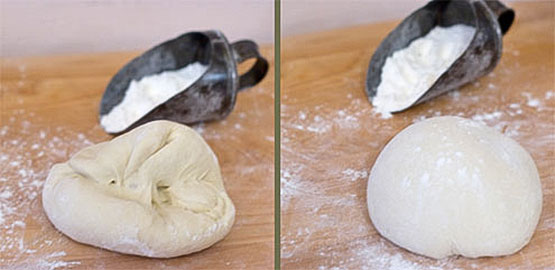Best Pasta with Pork Ragu Recipe
After the holiday’s indulgences, I’m sure I’m not the only one craving something homey and comforting like Pork Ragu. And after all the religious pomp and circumstances we were exposed to -voluntarily or not- during that time, I guess I’m also not the only one with a hankering for a little rebellion. That’s when an idea struck me. I knew just what I wanted to eat, Strozzapreti pasta.
Strozzapreti pasta is a traditional pasta shape from the Romagna region of Italy. The Italian name is literally priest-chokers in English. Legend has it that this particular shape, sort of resembling a short, twisted bit of rope, signified a religious rebellion in the region long suffered under Papal rule (from the 13th all the way to the 19th century).
Romagna housewives would cook this pasta for the local priests, in the hope that they would choke to death as they scoffed it down greedily. A heretic pasta for my very own post-holidays rebellion, how perfect! To go with this pasta I made a pork ragu. You don’t have to be Italian to find pork ragu homey, yes? This time my ragu would be made of pork, because why offend only one religion when you can easily do two (or three, actually)?
So that’s what I had for dinner, a heretic pasta in a haram (or trefah) pork ragu. I must admit, however, that my rebellion was rather short-lived. It took me and two dear friends and neighbors nearly half an hour to roll just enough for the three of us for dinner -those Romagna housewives were seriously vindictive- so we abandoned our hell-bound operation and turned the rest of the dough into Pici pasta, which is basically long, hand-rolled strips of slightly uneven thickness. The Pici are rustic and toothsome, not to mention much easier to deal with than Strozzapreti.
I couldn’t find a good recipe for Strozzapreti online, so I grabbed my well-loved copy of Cooking by Hand to see what recipe I could adapt for it. I found the recipe for Pici, which was described as a “fat, hand-formed pasta from the countryside surrounding Siena.” Since both Pici and Strozzapreti are hand-rolled, Paul (as in Bertoli, the author) described this dough from this recipe as being a little bit softer, easier for hand-rolling, with a little olive oil to guard against sticking, it sounded just perfect for what I needed.
If you’ve never made homemade pasta, I highly recommend this recipe. You won’t need specialty flour or equipment to make it. Trust me, it’s really easier than you think.
Here’s Paul Bertoli’s recipe for Pici pasta
Ingredients:
- 12oz (about 4 cups) “Baker’s Choice” flour, which is basically AP flour with a bit higher protein level. I used King Arthur AP flour
- 7oz (about 7/8 cup) cool water
- 3 1/2 tsp olive oil
Directions:
The recipe, like many rustic pasta recipes, calls for putting the flour right on the countertop or pastry board, then making a well in the center and pouring the wet ingredients into it, then, it suggests using a fork to slowly incorporate the liquid and the flour together. I strongly warn all but those with the dexterity of a monkey on crack against this method. The “well” wall will inevitably break, sending floury, sticky water streaming outwards and downwards like a room-temperature lava stream.
What I suggest instead is to measure your ingredients into a medium-sized bowl, then, with a fork, stir the ingredients together. You’ll end up with moist, lumpy, somewhat separated globs of incorporated dry and wet ingredients, which can be dumped onto the countertop without creating a mess. Work that dough a little, to get them to be a more or less cohesive dough. Don’t worry about kneading or making a smooth dough right now, just wrap it with some plastic and let rest for half an hour. This is to let the flour absorb the moisture completely before you knead and roll.


After half an hour, unwrap the dough onto a well-floured board. Wash your hands in cold tap water, dry them thoroughly, and dip them into your flour container to coat them with flour. Knead the dough, pressing the base of your palm into the dough, pushing forward a little, then fold the dough into itself and again push down and forward with your hand. Make sure the board and your hands are always well-floured to prevent sticking. Do it until you get a smooth, soft lump of dough. This shouldn’t take that much time at all.
To roll into the Strozzapreti shape, cut the dough into 8 pieces and roll each out thin, cut into about 3/4 inch wide and 3-4 inches long strips. Pick up each one and fold it into half lengthwise, then roll gently between your hands to make a folded, slightly twisted piece of pasta. Place them on a well-floured cookie sheet, making sure they are not touching each other because they will stick badly.


To roll into Pici, just cut out a small piece stretch and roll it into long strips. Come on, we’ve all played with Play-Doh, I don’t really need to teach you how to roll dough into long strips, do I? Anyway, see the picture above for what it’s supposed to look like.
If you plan to cook the pasta right away, make sure you cover the cookie sheets with a kitchen towel (yes, well-floured to prevent sticking). If not, the pasta will be dry in places, which will make them cook unevenly. If you intend to make a large amount of pasta and will have enough time (at least overnight) to let the paste dry thoroughly before you cook it, then don’t bother with the towel.
Pork Ragu Recipe
The recipe came from Paul Bertoli’s amazing book, Cooking by Hand. This is not a book for the faint of heart, I should warn you. The Ragù Alla Bolognese recipe alone is over 1,500 words–but who am I to complain about a long-winded treatise on a traditional dish, you’ve seen my Pad Thai recipe, right?
The recipe calls for beef, ground chuck, skirt, or hanger steak to be precise, but I made it with ground pork butt instead, because my friend doesn’t eat beef. (Yeah, you can choose your friends but you sure can’t choose what they eat!)
So, here’s my slightly bastardized version of Paul Bertoli’s Ragù Alla Bolognese. Hey, if you want the real thing you could always go buy the book.
Ingredients:
- 3 pounds pork
- 3.5oz pancetta, finely chopped
- 2 tablespoons of butter
- 1 celery stalk, chopped
- 1 carrot, chopped
- 1 onion, chopped
- a few sage leaves
- 3 oz tomato paste
- 6 cups of meat broth (water will do in a pinch, really)

Directions:
You start by browning the meat. Heat a large pot (I used my 8qt. Dutch Oven) over high heat, add a little oil, then spread the ground pork over the surface of the pot and brown it quickly on both sides. I found that doing this with half the batch of meat at a time allows the meat to brown up quickly and not overcooked by the time it’s done browning.
So if you do a half batch, spread half the pork over the surface of the pan and let brown, then flip it to the other side. Once brown on both sides, remove the first half of the pork. Let the pot stand to heat back up a bit, then add the other half of the meat and brown it up the same way.
Return the first half of the pork back to the pot, lower the heat to medium, and break up the brown pork into chunks. Add the pancetta and stir to mix well. Cut the butter into a few pieces and spread them over the top of the meat. Let melt for a few seconds, then stir well to mix.


Add the celery, carrots, and onion, give it a stir, and let the vegetables sweat with the meat for about 15 minutes. Add the sage leaves. Turn the heat down a bit if it looks like things are cooking up too quickly. While the vegetables and meat are cooking, heat up the meat broth or water in a medium pot.
After 15 minutes, add the tomato paste to the meat/veg mix. (You don’t have to weigh it really, I just use roughly 2/3 of my 4.5oz tube.) Stir to mix and let cook another 5 minutes.


Add about 1 cup of broth or water to the pork ragu pot, and stir to mix well. Let the meat absorb the liquid until almost dry, then add 1/2 cup more, and let the meat absorb it again. Continue adding 1/2 cup at a time, and let the meat absorb the liquid before adding more until you’ve used up about 3 cups (or half the amount) of the broth.
Lower the heat to simmer and add the rest of the broth. Let the pork ragu cook for at least an hour, until the liquid reduces to the consistency you like and the meat softens. Add water (or more broth) if the liquid in the pork ragu evaporates too quickly. I’d add a little salt here too if your broth doesn’t have salt (or if you use water.)
When the pork ragu is cooked properly, Check the seasoning. You might need to add a bit more salt. I like to add a little splash of sherry vinegar (or young balsamic vinegar) just to round up the flavor a bit. Add a little pepper if you’d like.
Serve the pork ragu with freshly made pasta, preferably Strozzapreti or Pici.
Reviews
Deliciously Hearty Pasta with Pork Ragu – A Must-Try Recipe!
I recently tried this Pasta with Pork Ragu recipe, and it was an absolute delight! This dish is a perfect blend of comforting and flavorful, making it a top pick for a satisfying meal. The step-by-step instructions were easy to follow, even for someone like me with limited cooking experience. The pork ragu sauce was rich and savory, coating the pasta perfectly. I highly recommend this recipe to anyone looking for a scrumptious Italian-inspired meal that’s both simple to prepare and utterly delicious!
